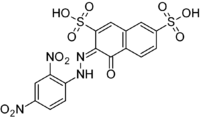Nitrazine
 | |
 | |
| Names | |
|---|---|
| IUPAC name
(3E)-3-[(2,4-Dinitrophenyl)hydrazono]-4-oxonaphthalene-2,7-disulfonic acid | |
| Other names
Nitrazine yellow; Phenaphthazine | |
| Identifiers | |
| 1716-22-9 | |
| ChemSpider | 5288340 |
| |
| Jmol-3D images | Image |
| PubChem | 6911856 |
| |
| Properties | |
| C16H10N4O11S2 | |
| Molar mass | 498.40 g/mol |
| Except where noted otherwise, data is given for materials in their standard state (at 25 °C (77 °F), 100 kPa) | |
| | |
| Infobox references | |
| Nitrazine (pH indicator) | ||
| below pH 4.5 | above pH 7.5 | |
| 4.5 | ⇌ | 7.5 |
Nitrazine or phenaphthazine is a pH indicator dye often used in medicine. More sensitive than litmus, nitrazine indicates pH in the range of 4.5 to 7.5. Nitrazine is usually used as the disodium salt. Some uses include:
- To test vaginal pH during late pregnancy to determine the breakage of the amniotic sac.[1] While vaginal pH is normally acidic, a pH above 7.0 can indicate that the amniotic sac has ruptured.[2] (However, elevated pH can also be associated with bacterial vaginosis.)[3]
- To perform a fecal pH test for diagnosing intestinal infections or other digestive problems[4]
- In civil engineering, to determine the carbonatation spread in concrete structures and therefore assess the state of the rebar's passivation film.
References
- ↑ Erdemoglu E; Mungan T (July 2004). "Significance of detecting insulin-like growth factor binding protein-1 in cervicovaginal secretions: comparison with nitrazine test and amniotic fluid volume assessment". Acta Obstet Gynecol Scand 83 (7): 622–6. doi:10.1111/j.0001-6349.2004.00343.x. PMID 15225185. Retrieved 2009-12-29.
- ↑ "Nitrazine paper".
- ↑ Sobel JD; Nyirjesy P; Kessary H; Ferris DG (September 2009). "Use of the VS-sense swab in diagnosing vulvovaginitis". J Womens Health (Larchmt) 18 (9): 1467–70. doi:10.1089/jwh.2008.1305. PMID 19743911.
- ↑ "Point-of-Care Testing, Fecal pH Measurement".